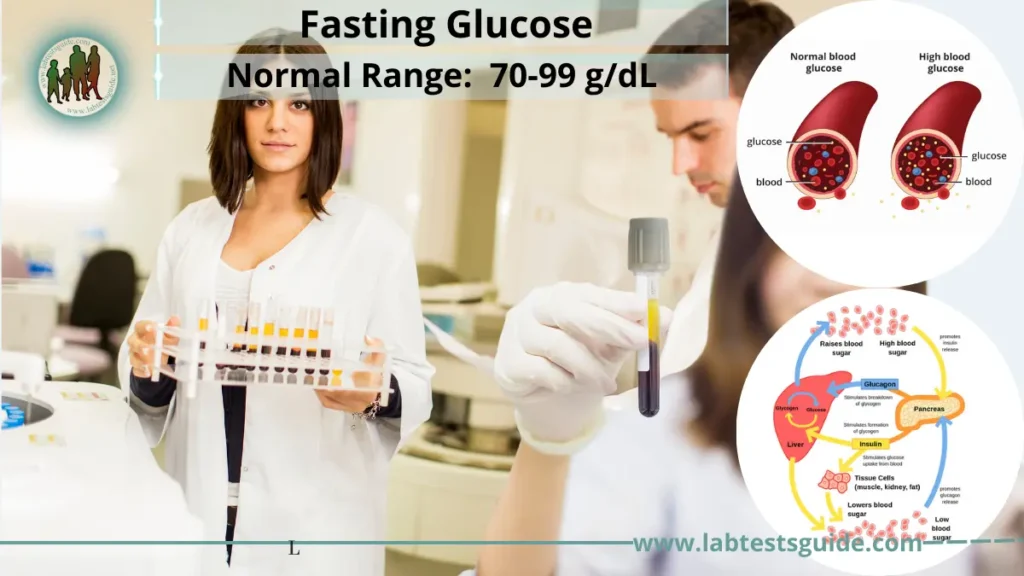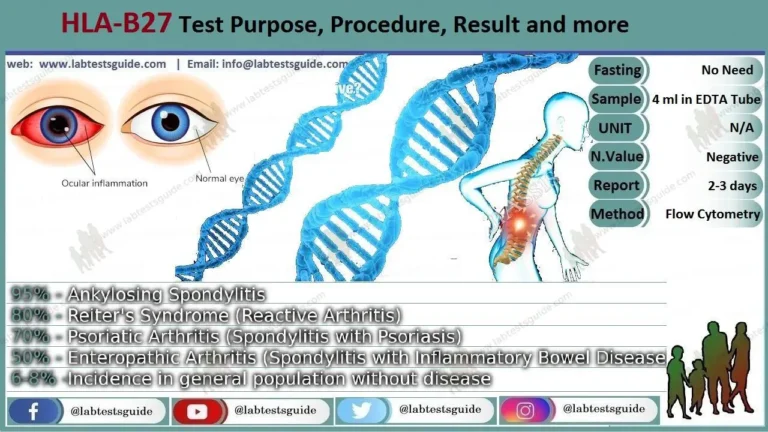Fasting Glucose Test, or fasting blood sugar, refers to the level of glucose in the bloodstream after a period of fasting, typically overnight or for at least eight hours without eating. It is a common measurement used to assess blood sugar control and screen for diabetes or prediabetes. It is typically used to quickly assess a person’s blood sugar level and can help diagnose diabetes or monitor blood sugar control in individuals already diagnosed with diabetes. Glucose (Sugar) is the primary source of energy for the body’s cells and is regulated by the hormone insulin, which is produced by the pancreas.

| Also Known as | BSR, BSF, BSL, Blood Sugar Random, Blood Glucose Random, RBS, Random Glucose, Random Sugar, Blood Sugar Fasting, Blood Glucose Fasting, Fasting Sugar, Fasting Glucose |
| Test Purpose | Describes how blood glucose tests are used, such as to screen for and diagnose prediabetes and diabetes, to detect hyperglycemia or hypoglycemia, and to monitor blood glucose levels over time when treating diabetes |
| Test Preparations | No Need any Preparation |
| Test Components | BSR (Blood Sugar Random) |
| Specimen | 2 ML Plasma From 1 Grey Top (Sodium Fluoride) Tube. |
| Stability Room | 6 Hrs |
| Stability Refrigerated | 72 Hrs |
| Stability Frozen | 1 Week |
| Method | Hexokinase |
| Download Report | Download Report |
Glucose Tests Panel :
Test Panel: Blood Sugar, Fasting Blood Sugar, FBS, Fasting Blood Glucose, FBG, Fasting Plasma Glucose, FPG, Blood Glucose, Oral Glucose Tolerance Test, OGTT, GTT, Urine Glucose, BSR, Random Blood Glucose, Random Plasma Glucose, HbA1c
Types of Blood Glucose (Sugar) Tests:
- Fasting Blood Glucose (Sugar) Test (FBS): This test measures the blood glucose level after a period of fasting, usually for at least 8 hours. It is typically done in the morning before breakfast and helps evaluate how the body regulates glucose during periods of fasting. It is commonly used to diagnose diabetes and monitor glucose control.
- Random Blood Glucose (Sugar) Test (RBS): This test measures the blood glucose level at any time of the day, regardless of when the person last ate. It is useful for quickly detecting high glucose levels and diagnosing diabetes in symptomatic individuals.
- Oral Glucose Tolerance Test (OGTT): This test involves measuring blood glucose levels before and after consuming a glucose-rich beverage. It is used to diagnose gestational diabetes in pregnant women and can also help identify impaired glucose tolerance or diabetes.
- Hemoglobin A1c (HbA1c) Test: This test provides an estimate of average blood glucose levels over the past two to three months. It measures the percentage of glucose attached to hemoglobin in red blood cells. The HbA1c test is commonly used to monitor long-term glucose control in individuals with diabetes.
- Continuous Glucose Monitoring (CGM): CGM involves wearing a small sensor beneath the skin that continuously measures glucose levels in the interstitial fluid. It provides real-time glucose readings and helps individuals with diabetes monitor their glucose levels throughout the day.
- Self-Monitoring of Blood Glucose (SMBG): SMBG involves using a glucose meter to measure blood glucose levels at home. It typically involves pricking the finger to obtain a small blood sample and then using a test strip with a glucose meter to obtain a reading. SMBG is commonly done by individuals with diabetes to monitor their glucose levels on a regular basis.
Why Get Tested:
- This test is done to diagnose diabetes mellitus.
- This test is also done to evaluate and monitoring of the patient with diabetes mellitus.
- This test is also done to detect and diagnose diabetes and prediabetes and to control high blood glucose (hyperglycemia) or low blood glucose (hypoglycemia)
When to Get Tested:
- when you are older than 45 and every three years.
- When you have risk factors for diabetes.
- when you have symptoms suggesting high or low blood glucose.
- During pregnancy.
Sampling and Preparations:
Test Preparation Needed :
- Fasting Blood Glucose (Sugar) Test (FBS):
- Typically, you will be required to fast for at least 8-10 hours before the test. This means no food or drink, except water, during the fasting period.
- It is advisable to schedule the test for early in the morning, as it is easier to meet the fasting requirement overnight.
- You should follow your healthcare provider’s instructions regarding any medication adjustments during the fasting period.
- Randome Blood Glucose (Sugar) Test (RBS):
- No special preparation is typically needed for this test. It can be performed at any time of the day, regardless of when you last ate.
- Oral Glucose Tolerance Test (OGTT):
- Your healthcare provider will provide specific instructions, including the duration of the fasting period before the test. It is usually around 8 to 12 hours.
- You will be asked to consume a glucose-rich beverage within a specific timeframe.
- During the test, you will need to remain at the testing facility, as blood samples will be taken at regular intervals.
- Hemoglobin A1c (HbA1c) Test:
- No specific preparation is required for this test. It reflects the average blood glucose levels over the past two to three months and is not affected by short-term fasting or meals.
Required Sample:
- Fasting Blood Glucose (Sugar) Test (FBS):: 2 mL (1 mL min.) Blood in 1 Grey Top (Sodium Fluoride) tube 0r Saperated (Plasma or Serum).
- Randome Blood Glucose (Sugar) Test (RBS): 2 mL (1 mL min.) Blood in 1 Grey Top (Sodium Fluoride) tube 0r Saperated (Plasma or Serum).
- Oral Glucose Tolerance Test (OGTT):
- 5 Samples: 2 mL (1 mL min.) Blood in 1 Grey Top (Sodium Fluoride) tube Or Saperated (Plasma or Serum) each for Fasting and Post glucose specimens.
- Collect fasting specimen .
- Dissolve 82.5g Glucose monohydrate in adults (equivalent to 75g anhydrous glucose) / 1.92 g / Kg body weight in children (not exceeding 82.5g) in 300 mL water.
- These samples are typically drawn at 30 minutes, 60 minutes, 90 minutes and 120 minutes after drinking the glucose
- Hemoglobin A1c (HbA1c) Test: 3 mL (2 mL min.) Whole blood in 1 Lavender Top (EDTA) tube. Store in refrigerated. DO NOT FREEZE.
Sample Preparation and Storage:
- Tests (BSR, BSF and OGTT) can be done on Plasma/Serum. The Plasma/serum should be separated within 30 minutes of collection.
- The Plasma/serum can be stored at 25° C for 8 hours and 72 hours at 4 °C.
- The plasma can be stored at 25 °C for 24 hours (when there is preservative sodium fluoride).
- HbA1c Sample: Store in refrigerated for 1 Week. DO NOT FREEZE.
Normal Values:
| Blood Glucose Test | Normal Range |
|---|---|
| Fasting Blood Glucose (FBS) | 70-99 mg/dL (3.9-5.5 mmol/L) |
| Random Blood Glucose (RBS) | 90-140 mg/dL (7.8 mmol/L) |
| OGTT (5 Samples) | Fasting | 70-99 mg/dL (3.9-5.5 mmol/L) 30-Minutes| 80 – 130 mg/dL (3.9-7.2 mmol/L) 60-Minutes | 110 – 180 mg/dL (3.9-9.99 mmol/L) 90-Minutes | 100 – 150 mg/dL (3.9-8.2 mmol/L) 120-Minutes | 90 – 140 mg/dL (3.9-7.8 mmol/L) |
| HbA1c | Upto 5.7% |
Please note that these values are general guidelines and may vary depending on the specific circumstances and healthcare provider’s recommendations. Additionally, normal ranges can vary slightly between laboratories. It is important to consult with your healthcare provider for the most accurate interpretation of your blood glucose test results based on your individual situation.
High glucose level (Hyperglycemia) seen in:
- Diabetes mellitus, adult and juvenile.
- Physiological causes.
- Strenuous exercise.
- Strong emotions.
- Shock and burns.
- Infections.
- Endocrine disorders.
- Thyrotoxicosis
- Acromegaly and gigantism.
- Pheochromocytoma.
- Cushing’s syndrome.
- Pancreatic diseases.
- Acute and chronic pancreatitis.
- Pancreatitis due to mumps.
- Cystic fibrosis.
- Hemochromatosis.
- Pancreatic cancers.
- other causes are:
- Cerebrovascular accident.
- Chronic liver disease.
- Chronic renal disease.
- Acanthosis nigricans.
Low Glucose level (Hyperglycemia) seen in:
- Diabetes: Hypoglycemia can occur in individuals with diabetes who take insulin or certain medications to lower blood glucose levels.
- Insulinoma: This rare tumor of the pancreas produces excessive amounts of insulin, leading to low blood glucose levels.
- Reactive hypoglycemia: Some individuals experience a drop in blood glucose levels a few hours after consuming a high-carbohydrate meal.
- Malnutrition or inadequate food intake: Insufficient calorie intake or malnutrition can result in low glucose levels.
- Alcohol consumption: Excessive alcohol intake can interfere with the liver’s ability to release stored glucose, leading to hypoglycemia.
- Certain medications: Some medications, such as certain antibiotics or anti-diabetic drugs, can cause low blood glucose levels as a side effect.
- Hormonal deficiencies: Deficiencies in hormones such as cortisol or growth hormone can contribute to hypoglycemia.
- Liver or kidney disease: Dysfunction of the liver or kidneys can affect the regulation of blood glucose levels.
FAQs :
What is blood glucose?
Answer: Blood glucose, also known as blood sugar, is the main sugar found in the bloodstream and serves as the primary source of energy for the body’s cells.
What is a normal fasting blood glucose level?
Answer: A normal fasting blood glucose level is typically between 70-99 mg/dL (3.9-5.5 mmol/L).
What is hyperglycemia?
Answer: Hyperglycemia refers to high blood glucose levels, often associated with conditions such as diabetes.
What is hypoglycemia?
Answer: Hypoglycemia refers to low blood glucose levels, usually below 70 mg/dL (3.9 mmol/L), and can cause symptoms such as dizziness, weakness, and confusion.
What is HbA1c?
Answer: HbA1c, also known as glycated hemoglobin, is a blood test that measures average blood glucose levels over the past two to three months. It is commonly used to assess long-term blood sugar control in individuals with diabetes.
What is the oral glucose tolerance test (OGTT)?
Answer: The OGTT is a diagnostic test to evaluate how the body processes glucose. It involves drinking a glucose solution, and blood glucose levels are measured at various time intervals afterward.
What is the dawn phenomenon?
Answer: The dawn phenomenon refers to the natural rise in blood glucose levels in the early morning hours, often observed in people with diabetes.
What is the Somogyi effect?
Answer: The Somogyi effect, also known as rebound hyperglycemia, is a phenomenon where blood glucose levels swing high after experiencing hypoglycemia during the night.
What is the target range for blood glucose control in diabetes?
Answer: The target range for blood glucose control in diabetes may vary depending on individual factors, but generally, a target range of 80-130 mg/dL (4.4-7.2 mmol/L) before meals and less than 180 mg/dL (10.0 mmol/L) after meals is recommended.
What are the symptoms of high blood glucose levels?
Answer: Symptoms of high blood glucose levels (hyperglycemia) can include excessive thirst, frequent urination, fatigue, blurred vision, and unexplained weight loss.
What are the symptoms of low blood glucose levels?
Answer: Symptoms of low blood glucose levels (hypoglycemia) can include sweating, trembling, dizziness, confusion, weakness, and hunger.
Conclusion :
In conclusion, blood glucose levels play a crucial role in maintaining our overall health and well-being. Monitoring and understanding blood glucose levels is particularly important for individuals with diabetes or those at risk of developing diabetes. High blood glucose levels, known as hyperglycemia, can be a sign of poor blood sugar control and can have adverse effects on the body. On the other hand, low blood glucose levels, called hypoglycemia, can lead to symptoms such as dizziness, confusion, and weakness.
Various blood glucose tests, such as fasting blood glucose, oral glucose tolerance test (OGTT), and HbA1c, are used to assess blood glucose levels and diagnose conditions like diabetes. These tests require specific preparations and sample collection procedures, which may vary depending on the test.
Home | Blog | About Us | Contact Us | Disclaimer
Possible References Used





